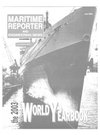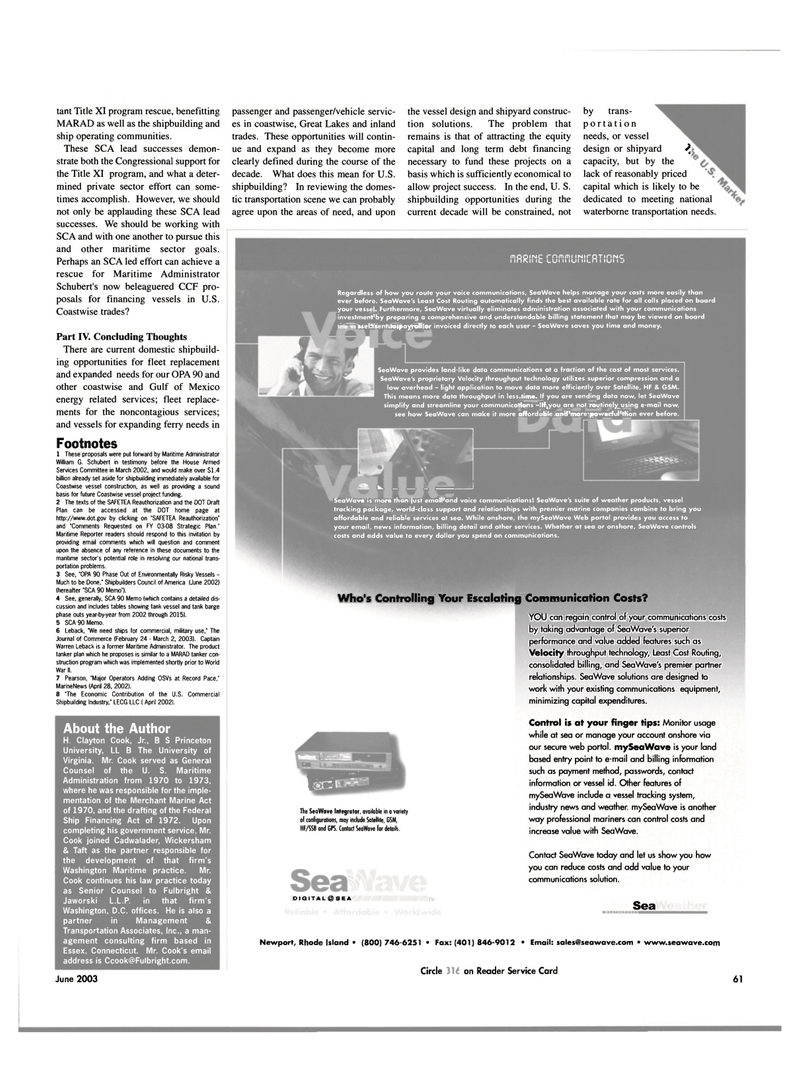
Page 61: of Maritime Reporter Magazine (June 2003)
Read this page in Pdf, Flash or Html5 edition of June 2003 Maritime Reporter Magazine
tant Title XI program rescue, benefitting
MARAD as well as the shipbuilding and ship operating communities.
These SCA lead successes demon- strate both the Congressional support for the Title XI program, and what a deter- mined private sector effort can some- times accomplish. However, we should not only be applauding these SCA lead successes. We should be working with
SCA and with one another to pursue this and other maritime sector goals.
Perhaps an SCA led effort can achieve a rescue for Maritime Administrator
Schubert's now beleaguered CCF pro- posals for financing vessels in U.S.
Coastwise trades?
Part IV. Concluding Thoughts
There are current domestic shipbuild- ing opportunities for fleet replacement and expanded needs for our OPA 90 and other coastwise and Gulf of Mexico energy related services; fleet replace- ments for the noncontagious services; and vessels for expanding ferry needs in
Footnotes 1 These proposals were put forward by Maritime Administrator
William G. Schubert in testimony before the House Armed
Services Committee in March 2002, and would make over $1.4 billion already set aside for shipbuilding immediately available for
Coastwise vessel construction, as well as providing a sound basis for future Coastwise vessel project funding. 2 The texts of the SAFETEA Reauthorization and the DOT Draft
Plan can be accessed at the DOT home page at http://www.dot.gov by clicking on "SAFETEA Reauthorization" and "Comments Requested on FY 03-08 Strategic Plan."
Maritime Reporter readers should respond to this invitation by providing email comments which will question and comment upon the absence of any reference in these documents to the maritime sector's potential role in resolving our national trans- portation problems. 3 See, "OPA 90 Phase Out of Environmentally Risky Vessels -
Much to be Done," Shipbuilders Council of America (June 2002) (hereafter "SCA 90 Memo"). 4 See, generally, SCA 90 Memo (which contains a detailed dis- cussion and includes tables showing tank vessel and tank barge phase outs year-by-year from 2002 through 2015). 5 SCA 90 Memo. 6 Leback, "We need ships for commercial, military use," The
Journal of Commerce (February 24 - March 2, 2003). Captain
Warren Leback is a former Maritime Administrator. The product tanker plan which he proposes is similar to a MARAD tanker con- struction program which was implemented shortly prior to World
War II. 7 Pearson, "Major Operators Adding OSVs at Record Pace,"
MarineNews (April 28, 2002). 8 "The Economic Contribution of the U.S. Commercial
Shipbuilding Industry," LECG LLC ( April 2002).
About the Author
H. Clayton Cook, Jr., B S Princeton
University, LL B The University of
Virginia. Mr. Cook served as General
Counsel of the U. S. Maritime
Administration from 1970 to 1973, where he was responsible for the imple- mentation of the Merchant Marine Act of 1970, and the drafting of the Federal
Ship Financing Act of 1972. Upon completing his government service, Mr.
Cook joined Cadwalader, Wickersham & Taft as the partner responsible for the development of that firm's
Washington Maritime practice. Mr.
Cook continues his law practice today as Senior Counsel to Fulbright &
Jaworski L.L.P in that firm's
Washington, D.C. offices. He is also a partner in Management &
Transportation Associates, Inc., a man- agement consulting firm based in
Essex, Connecticut. Mr. Cook's email address is [email protected]. passenger and passenger/vehicle servic- es in coastwise, Great Lakes and inland trades. These opportunities will contin- ue and expand as they become more clearly defined during the course of the decade. What does this mean for U.S. shipbuilding? In reviewing the domes- tic transportation scene we can probably agree upon the areas of need, and upon the vessel design and shipyard construc- tion solutions. The problem that remains is that of attracting the equity capital and long term debt financing necessary to fund these projects on a basis which is sufficiently economical to allow project success. In the end, U. S. shipbuilding opportunities during the current decade will be constrained, not by trans- port a t i o n needs, or vessel design or shipyard ^ capacity, but by the lack of reasonably priced capital which is likely to be dedicated to meeting national waterborne transportation needs. mooiiMC rnmmiiNiroTiriNC iinKniC «_Ui ti luiliLn i lui i j
Regardless of how you route your voice communications, SeaWave helps manage your costs more easily than ever before. SeaWave's Least Cost Routing automatically finds the best available rate for all calls placed on board your vessel. Furthermore, SeaWave virtually eliminates administration associated with your communications investment by preparing a comprehensive and understandable billing statement that may be viewed on board " —"" ent to payroll or invoiced directly to each user - SeaWave saves you time and money. CO
SeaWave provides land-like data communications at a fraction of the cost of most services.
SeaWave's proprietary Velocity throughput technology utilizes superior compression and a low overhead - light application to move data more efficiently over Satellite, HF & GSM.
This means more data throughput in less time. If you are sending data now, let SeaWave simplify and streamline your communications - If you are not routinely using e-mail now, see how SeaWave can make it more affordable and more powerful than ever before. kj fr._ I
SeaWave is more than just email and voice communications! SeaWave's suite of weather products, vessel tracking package, world-class support and relationships with premier marine companies combine to bring you affordable and reliable services at sea. While onshore, the mySeaWave Web portal provides you access to your email, news information, billing detail and other services. Whether at sea or onshore, SeaWave controls costs and adds value to every dollar you spend on communications.
Who's Controlling Your Escalating Communication Costs?
The SeaWave Integrator, available in a variety of configurations, may include Satellite, GSM,
HF/SS8 and GPS. Contort SeaWave for details.
DIGITAL @ SEA
YOU can regain control of your communications costs by taking advantage of SeaWave's superior performance and value added features such as
Velocity throughput technology, Least Cost Routing, consolidated billing, and SeaWave's premier partner relationships. SeaWave solutions are designed to work with your existing communications equipment, minimizing capital expenditures.
Control is at your finger tips: Monitor usage while at sea or manage your account onshore via our secure web portal. mySeaWave is your land based entry point to e-mail and billing information such as payment method, passwords, contact information or vessel id. Other features of mySeaWave include a vessel tracking system, industry news and weather. mySeaWave is another way professional mariners can control costs and increase value with SeaWave.
Contact SeaWave today and let us show you how you can reduce costs and add value to your communications solution.
Sea
June 2003
Newport, Rhode Island • (800) 746-6251 • Fax: (401) 846-9012 • Email: [email protected] • www.seawave.com
Circle 278 on Reader Service Card 61

 60
60

 62
62
